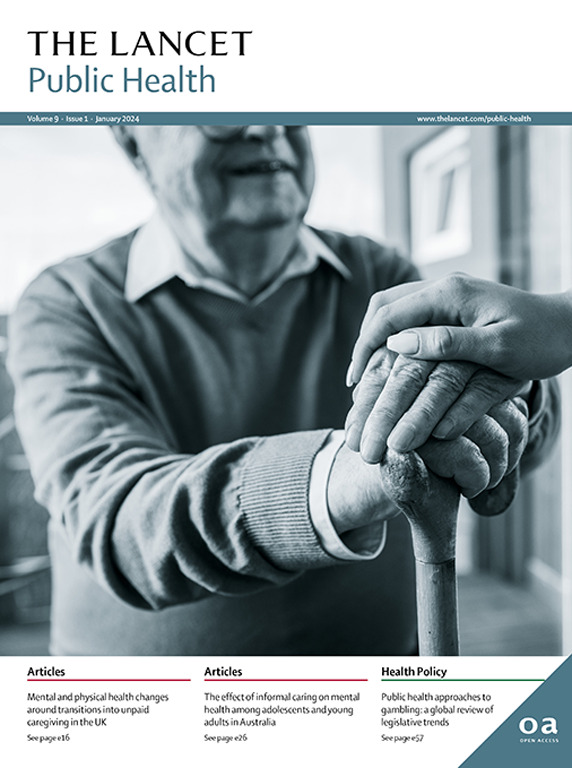Homelessness, psychiatric disorders, and risks of suicide and self-harm: a population-based cohort study
IF 25.2
1区 医学
Q1 PUBLIC, ENVIRONMENTAL & OCCUPATIONAL HEALTH
引用次数: 0
Abstract
Background
Homelessness is associated with adverse outcomes, but associations with suicide and self-harm require careful examination. We examined risks of suicidal behaviours in people experiencing homelessness compared with the general population, and the contribution of psychiatric disorders.Methods
Nationwide, register-based data on people living in Denmark between Jan 1, 1999, and Dec 31, 2020, born between 1945 and 2006 and aged 15–76 years, were analysed. Homelessness was measured as any homelessness or current homelessness and previous homelessness. Outcomes were first self-harm episode and death by suicide. We estimated adjusted mortality rate ratios (aMRRs) and adjusted incidence rate ratios (aIRRs) in Poisson regression and probabilities of outcomes. Analyses were stratified by sex and adjusted for sociodemographic factors and psychiatric disorders.Findings
Among 5 188 284 residents, 56 663 (1·1%) had at least one episode of homelessness, accounting for 570 986 person-years. Within 10 years of first homeless shelter contact, 1·3% (95% CI 1·2–1·4%) of males and 0·9% (0·7–1·0%) of females had died by suicide and 9·2% (8·9–9·6%) of males and 9·9% (9·4–10·5%) of females self-harmed. Homelessness was associated with an elevated rate of suicide (males aMRR 2·2 [2·0–2·4]; females 3·8 [3·2–4·5]) and self-harm (males 3·5 [3·4–3·6]; females 3·3 [3·1–3·5]) compared with no homelessness. Current homelessness compared with no homelessness was associated with elevated adjusted suicide rates (males 3·7 [3·1–4·5]; females 8·0 [5·5–11·6]), which were higher than for previous homelessness (males 2·0 [1·8–2·2]; females 3·4 [2·8–4·1]). Psychiatric disorders added further risk of suicidality among people experiencing homelessness compared with no psychiatric disorder and no homelessness (males 19·9 [18·1–22·0]; too few cases for females). Self-harm in people experiencing homelessness increased risk of dying by suicide (males 7·4 [6·5–8·5]; females 17·7 [14·4–21·7]).Interpretation
Individuals experiencing homelessness have elevated risks of self-harm and suicide, particularly those who are currently homeless. An episode of self-harm and psychiatric disorders are important indicators of suicide in this vulnerable group. Findings highlight a need for improving assessment and intervention.Funding
Independent Research Fund Denmark and NIHR Oxford Health Biomedical Research Centre.无家可归、精神疾病、自杀和自残风险:一项基于人群的队列研究
无家可归与不良后果有关,但与自杀和自残的关系需要仔细研究。我们研究了无家可归者与普通人群相比自杀行为的风险,以及精神疾病的影响。方法对1999年1月1日至2020年12月31日期间居住在丹麦、出生于1945年至2006年、年龄在15岁至76岁之间的人口进行全国范围内的登记数据分析。无家可归被衡量为任何无家可归者或现在的无家可归者和以前的无家可归者。结果是首次自残发作和自杀死亡。我们估计了泊松回归中的调整死亡率比(amrr)和调整发病率比(aIRRs)以及结果的概率。分析按性别分层,并根据社会人口因素和精神障碍进行调整。结果5 18284名居民中,有56 663人(1.1%)至少有一次无家可归的经历,占570 986人年。在首次接触无家可归者收容所的10年内,1.3% (95% CI 1.21 - 1.4%)的男性和0.9% (95% CI 0.7 - 1.0%)的女性死于自杀,9.2%(8.9 - 9.6%)的男性和9.9%(9.4 - 10.5%)的女性自残。无家可归与自杀率升高有关(男性aMRR为2.2 [2.0 - 2.4];女性3·8[3·2-4·5])和自残(男性3·5[3·4-3·6];女性3·3[3·1-3·5]),与无无家可归者相比。与没有无家可归者相比,目前无家可归者与调整后的自杀率升高有关(男性3.7[3.1 - 4·5];女性为8.0[5.5 - 11.6]),高于之前的无家可归者(男性为2.0 [1.8 - 2.2];雌性3·4[2·8-4·1])。与无精神障碍和无无家可归者相比,精神障碍增加了无家可归者的自杀风险(男性19.9 [18.1 - 22.0];女性病例太少)。无家可归者自残增加自杀死亡风险(男性7.4 [6.5 - 8.5];雌性17.7[14.4 ~ 21.7])。无家可归的人自残和自杀的风险较高,尤其是那些目前无家可归的人。自残和精神障碍是这一弱势群体自杀的重要指标。研究结果强调了改进评估和干预的必要性。资助丹麦独立研究基金和英国国家卫生研究院牛津健康生物医学研究中心。
本文章由计算机程序翻译,如有差异,请以英文原文为准。
求助全文
约1分钟内获得全文
求助全文
来源期刊

Lancet Public Health
Medicine-Public Health, Environmental and Occupational Health
CiteScore
55.60
自引率
0.80%
发文量
305
审稿时长
8 weeks
期刊介绍:
The Lancet Public Health is committed to tackling the most pressing issues across all aspects of public health. We have a strong commitment to using science to improve health equity and social justice. In line with the values and vision of The Lancet, we take a broad and inclusive approach to public health and are interested in interdisciplinary research.
We publish a range of content types that can advance public health policies and outcomes. These include Articles, Review, Comment, and Correspondence. Learn more about the types of papers we publish.
 求助内容:
求助内容: 应助结果提醒方式:
应助结果提醒方式:


